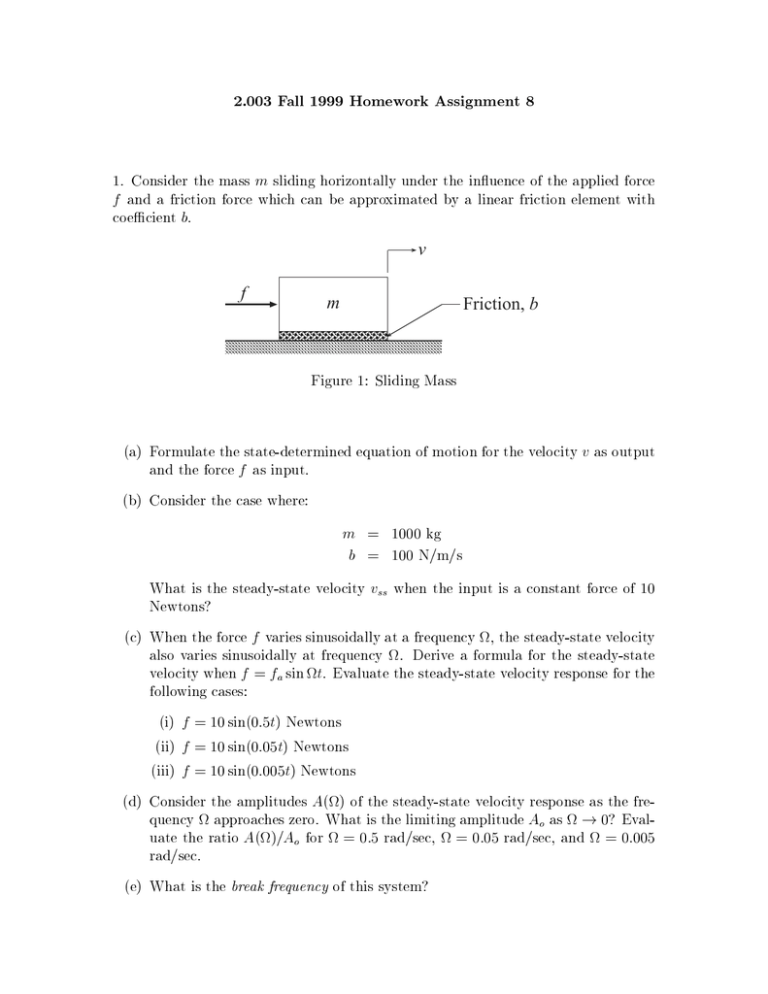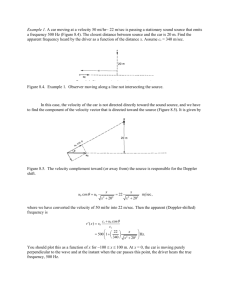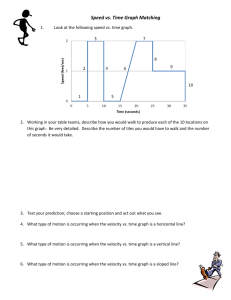m v f Friction, b
advertisement

2.003 Fall 1999 Homework Assignment 8 1. Consider the mass m sliding horizontally under the inuence of the applied force f and a friction force which can be approximated by a linear friction element with coecient b. v f m Friction, b Figure 1: Sliding Mass (a) Formulate the state-determined equation of motion for the velocity v as output and the force f as input. (b) Consider the case where: m = 1000 kg b = 100 N/m/s What is the steady-state velocity vss when the input is a constant force of 10 Newtons? (c) When the force f varies sinusoidally at a frequency , the steady-state velocity also varies sinusoidally at frequency . Derive a formula for the steady-state velocity when f = fa sin t. Evaluate the steady-state velocity response for the following cases: (i) f = 10 sin(0:5t) Newtons (ii) f = 10 sin(0:05t) Newtons (iii) f = 10 sin(0:005t) Newtons (d) Consider the amplitudes A( ) of the steady-state velocity response as the frequency approaches zero. What is the limiting amplitude Ao as ! 0? Evaluate the ratio A( )=Ao for = 0:5 rad/sec, = 0:05 rad/sec, and = 0:005 rad/sec. (e) What is the break frequency of this system? (f) Make an accurate, labelled, sketch of the Bode plots for the amplitude ratio A( )=Ao and the phase angle ( ) of this system. 2. Consider the rotor with moment of inertia I rotating under the inuence of an applied torque T and the frictional torques from two bearings, each of which can be approximated by a linear frictional element with coecient B . T B ω B I Figure 2: Rotating Inertia (a) Formulate the state-determined equation of motion for the angular velocity ! as output and the torque T as input. (b) Consider the case where: I = 0:001 kg-m2 B = 0:005 N-m/r/s What is the steady-state velocity !ss when the input is a constant torque of 10 Newton-meters? (c) When the torque T varies sinusoidally at a frequency , the steady-state angular velocity also varies sinusoidally at frequency . Derive a formula for the steadystate angular velocity when T = Ta sin t. Evaluate the steady-state angular velocity response for the following cases: (i) T = 10 sin(50t) Newton-meters (ii) T = 10 sin(5t) Newton-meters (iii) T = 10 sin(0:5t) Newton-meters (d) Consider the amplitudes A( ) of the steady-state angular velocity response as the frequency approaches zero. What is the limiting amplitude Ao as ! 0? Evaluate the ratio A( )=Ao for = 50 rad/sec, = 5 rad/sec, and = 0:5 rad/sec. (e) What is the break frequency of this system? (f) Make an accurate, labelled, sketch of the Bode plots for the amplitude ratio A( )=Ao and the phase angle ( ) of this system. 3. In a CD player the disc with moment of inertia Id is mounted directly on the shaft of an electric motor, whose rotor has a moment of inertia Ir . The unit experiences a frictional retarding torque that can be modeled by a linear damper with damping coecient Bm . The parameter values for the system are estimated to have the following values: Id = 5e-5 kg-m2 Ir = 9e-6 kg-m2 Bm = 9e-5 N-m/rad/sec Formulate the state-determined equation of motion for rotation with the angular velocity !m as the output and the motor torque Tm as the input. (a) Consider the steady-state sinusoidal oscillation of !m in response to an input torque of the form Tm = Ta sin t. Calculate the response amplitude and phase angle for three frequencies: = 1rad=sec = 5rad=sec = 15rad=sec for each of the following cases: (i) No disc mounted on the motor spindle (ii) A disc is mounted on the spindle (b) Evaluate the break frequency for each of the following cases: (i) No disc mounted on the motor spindle (ii) A disc is mounted on the spindle (c) Make an accurate, labeled, sketch of the Bode plots for amplitude ratio and phase angle for each of the following cases: (i) No disc mounted on the motor spindle (ii) A disc is mounted on the spindle (d) If the input torques are applied to the rotor initially at rest, estimate how long it takes to reach the steady state (for most practical purposes, steady state may be assumed to be reached at the end of 4 decay time-constants, when 98% of the transient has decayed). Do this for each of the three values of , for each of the following cases: (i) No disc mounted on the motor spindle (ii) A disc is mounted on the spindle 4. Vibration of an engine due to motion of a single piston. A single piston weighs 1 pound and oscillates at frequency with a total stroke (top to bottom of piston travel) of 2 inches. (a) Assuming that the piston motion is sinusoidal, calculate the amplitude of the sinusoidal force that is required to move the piston at the following crankshaft speeds in revolutions per minute (rpm): N = 1500 rpm N = 3000 rpm N = 6000 rpm (b) The piston in (a) is assumed to be part of an engine, which weighs 200 pounds, and which is supported on a xed frame by mounts which have an eective stiness (for vertical motion) of 18,000 pounds/inch, and an eective llnear damping coecient of 2 pounds/inch/sec. The oscillating forces considered in (a) are forces acting on the piston. By Newton's law of action and reaction, equal and opposite forces act on the engine block whenever the crankshaft rotates at the speeds considered. The rest of the problem is devoted to estimating how much vibration of the engine block results from the action of one piston. Formulate an equation of motion for the engine block in which the output is the displacement of the engine block, and the input is the reaction force from the motion of one piston. (c) Derive expressions for the amplitude and phase of the steady-state displacement response to piston reaction forces of the form f (t) = fa sin t. (d) Estimate the amplitude of the engine block displacement, due to the motion of one piston, when the engine operates at N = 1600rpm N = 1800rpm N = 2000rpm (e) If these three speeds are generated by starting with the engine block at rest, in equilibrium, and then immediately rotating the crankshaft at the full indicated speed, estimate how long it would take the engine block, in each case, to reach steady state vibration.



